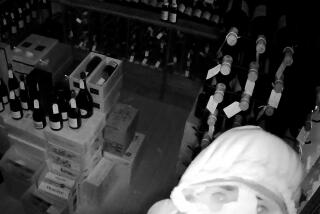Still buying wine by the bottle? Try the <i>case</i>
THE SUMMER season means backyard barbecues, big events such as weddings and showers, and serendipitous gatherings like impromptu pool parties and after-work get-togethers on the patio. All great reasons to have a nice bottle of wine on hand, one thatâs refreshing in hot weather and inexpensive enough to serve to larger groups of guests without flinching.
We each have our own flinch point when it comes to wine. For me, a great summer bottle costs around $8 to $12, and when I find that great summer bottle, I buy it by the case, for several reasons. The first is convenience; it avoids the frenzied last-minute run to the nearest liquor store to buy four bottles of whatever looks good. The second reason is to save money. Many retailers give a case discount of 5% to 15%. Even if thereâs no case discount -- those retailers say that the price is already discounted -- youâre saving money by avoiding unnecessary trips to the wine store.
Finally, itâs just more relaxing to know that youâre well-supplied with terrific wine, no matter whoâs expected for dinner or whatâs on the menu. Weâre all looking for ways to simplify our lives. The strategic summer âcase buyâ is one of those ways.
This year, the search for affordable wines of quality requires a different road map. The anemic dollar has caused many traditional European summer picks to edge past my personal flinch point. I fondly recall past summers that were pleasantly lubricated by oceans of better-quality Italian Soave and Pinot Grigio, waves of French Beaujolais from excellent small producers, and rivers of delightfully tart Muscadet, all of which could be ferreted out for around $10 to $12 a bottle, sometimes even less. Those days are gone, but other wine regions and countries have moved to the forefront of the affordable wine scene, such as Austria, Spain, California, New Zealand and southern France and Italy.
A serendipitous blend
TO BE a great summer case buy, a wine should not only be inexpensive, but also be sippable on its own as well as complementary to a variety of foods. In white wine, look for a fresh, aromatic bouquet; a light to medium body; and a crisp acidity level to make it refreshing and to pair with lighter summer meals of salads, sushi, grilled chicken and fish. Stay away from big, oaky, high-alcohol wines, white or red. In hot weather theyâre tiring to drink.
Grape types that work well for summer whites include GrĂźner Veltliner, Chenin Blanc, Pinot Grigio, Sauvignon Blanc, AlbariĂąo and Riesling.
For summer red wine case buys, steer clear of tannic, high-alcohol Cabs and Zins and look for lighter, fruitier bottlings made from grapes such as Tempranillo, Gamay, Grenache and other RhĂ´ne varietals, and various Italians, including Nero dâAvola and Montepulciano. (Pinot Noir would be ideal, but itâs tough to find a palatable Pinot for less than $12).
Wines that deliver flavor and good acidity will stand up to summerâs mixed grills, pairing well with burgers, portobello mushrooms, ribs or tri-tip. If the red can take a little chill -- say, a half-hour in the fridge -- so much the better. During warm weather, reds taste best at cool room temperature.
Whatever wine youâre considering, itâs important to check the label for the alcohol content, a pretty accurate indicator of the wineâs heft and balance.
Wines with alcohol levels of 14% or more can taste heavy and hot during the summer (during the winter too, but thatâs another subject). And because higher-alcohol wines really pack a punch, they are a poor choice for pouring at a summer party, unless you have planned for all 18 guests to spend the night.
Though reds with an attractive and balanced fruit component taste great in summer, for case buys itâs a good idea to avoid so-called fruit bombs, wines that deliver a blast of ripe cherry-berry aromas, a hefty dose of alcohol and not much else. Initially, fruit bombs can be seductive. Those first sips may taste great, but youâll become bored with them. Itâs like dating someone half your age. Thereâs that immediate, in-your-face appeal, but no depth. They canât hold up their end of the conversation; they donât leave you wanting more. After the third date/bottle, youâre asking yourself, âWhat was I thinking?â
Strategizing
FOR A buying strategy, there are several options. You can head to your supermarket, gourmet grocer, membership warehouse or wine chain store, and pick up what theyâre featuring in this price range. That can work; last summer, after a tip from Wine Spectator columnist Matt Kramer, I bought a ton of very good 2005 Louis Jadot Beaujolais at Vons, which briefly had it on sale for -- I swear -- $7 a bottle. (This year, the wine isnât as good and, needless to say, that price point is histoire.) Trader Joeâs has terrific buys, but inventory differs from store to store and small lots sell out, so securing a case can be frustrating.
Another way to sample wine for a case buy is at restaurants and wine bars, which can be a great method of finding bottles you like in your price range (keeping in mind the substantial markup on most wine lists). Tracking down your finds can be a challenge. The first step is to look at the wine label and write down the wine name, producer and vintage, as well as its importer or distributor. Then you can call a local wine retailer to see if they carry the wine or can order it, or call the distributor and ask which retailers stock it. Another tactic is to put the wine name plus your city into a search engine and see what comes up. Either way, expect to make multiple phone calls, but the right wine is worth the trouble.
The other strategy -- and my favorite -- is to visit your local independent wine retailer and taste their recommendations in your price range.
In recent weeks, Iâve made the rounds (yes, tough job) and found eight amazingly inexpensive bottles that will make great summer sipping this season. Your favorite retailer may have several options that are equally good and cheap. Some wine shops have wine in this price range open and available to taste, but more often youâll have to buy a bottle or two, so itâs best to explain very specifically what kinds of wine you like and what price youâre looking to pay.
Donât invest in a case without trying a bottle. In other words, donât take my word for it, and donât take the retailerâs word either. Taste is subjective, and buying wine is not like picking up a sweater at Macyâs; many retailers wonât take back unopened bottles, at least in part due to concerns about how the wine may have been handled outside the store (a few hours in a car trunk on a sunny day can ruin wine).
Once youâve found a wine you like, a case buy (or multiple cases, if you have thirsty friends) means youâll have it on hand through the summer. And I hear it could be a hot one.
More to Read
Sign up for The Wild
Weâll help you find the best places to hike, bike and run, as well as the perfect silent spots for meditation and yoga.
You may occasionally receive promotional content from the Los Angeles Times.










